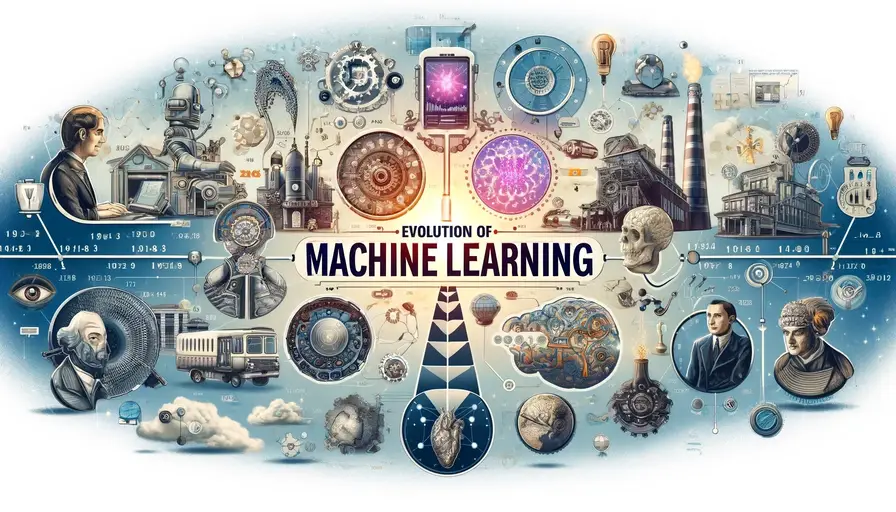1950s
- 1950: Alan Turing proposes the concept of a “learning machine” that could improve over time.
- 1957: Frank Rosenblatt develops the perceptron algorithm, an early type of artificial neuron.
1960s
- 1960s: Early machine learning algorithms, such as the nearest neighbor algorithm, are developed.
- 1967: The nearest neighbor algorithm is used for pattern recognition tasks.
1970s
- 1970s: The field of machine learning stagnates due to limited computational power and data.
- 1979: Kunihiko Fukushima proposes the neocognitron, a precursor to convolutional neural networks.
1980s
- 1980s: Resurgence of machine learning with the development of backpropagation for training neural networks.
- 1986: David Rumelhart, Geoffrey Hinton, and Ronald J. Williams popularize backpropagation.
1990s
- 1990s: Introduction of support vector machines (SVMs) by Vladimir Vapnik and colleagues.
- 1995: Leo Breiman develops the random forest algorithm, improving model accuracy through ensemble learning.
2000s
- 2000s: The rise of big data provides vast amounts of data for training machine learning models.
- 2006: Geoffrey Hinton and Ruslan Salakhutdinov publish a paper on deep belief networks, sparking interest in deep learning.
2010s
- 2010s: Deep learning gains prominence with the development of powerful neural networks and increased computational power.
- 2012: AlexNet, a deep convolutional neural network, wins the ImageNet Large Scale Visual Recognition Challenge.
- 2014: Ian Goodfellow introduces generative adversarial networks (GANs).
- 2015: The transformer model is introduced, revolutionizing natural language processing.
- 2017: Google’s AlphaGo, powered by deep reinforcement learning, defeats the world champion in Go.
2020s
- 2020s: Continued advancements in reinforcement learning, natural language processing, and explainable AI.
- 2020: OpenAI releases GPT-3, a state-of-the-art language model with 175 billion parameters.
- 2021: AlphaFold, developed by DeepMind, makes significant breakthroughs in protein structure prediction.
Future Prospects
- Future: Ongoing research in areas like reinforcement learning, explainable AI, and ethical AI aims to address current challenges and unlock new possibilities in machine learning applications.
This timeline highlights the key milestones in the evolution of machine learning, showcasing the progression from early theoretical concepts to modern advancements in deep learning and beyond.
Machine Learning Has Evolved Over Time
Machine learning has experienced significant evolution due to advancements in technology and the development of sophisticated algorithms. Early machine learning efforts were limited by computational power and data availability, but as technology advanced, so did the capabilities of machine learning systems. Technological advancements such as improved hardware, faster processors, and increased storage capacities have enabled the processing of larger datasets and the execution of more complex algorithms.
Another critical factor in the evolution of machine learning is the development of algorithms. Early algorithms were relatively simple, focusing on linear relationships and basic pattern recognition. Over time, researchers developed more complex algorithms, including neural networks, decision trees, and support vector machines, which allowed for better handling of non-linear relationships and more sophisticated pattern recognition.
Moreover, the growth of the data science community and the sharing of knowledge through academic publications, open-source projects, and conferences have accelerated the pace of innovation in machine learning. Collaboration and competition have driven the creation of new techniques and methodologies, further propelling the field forward.
The History of Machine Learning 1950s and 1960s
The history of machine learning dates back to the 1950s and 1960s when researchers in artificial intelligence (AI) began exploring ways to enable machines to learn from data. One of the earliest attempts was the creation of programs that could play games like chess and checkers. These early efforts laid the groundwork for more advanced machine learning techniques by demonstrating that machines could be programmed to perform tasks traditionally thought to require human intelligence.
In the 1950s, Alan Turing, a pioneer in computer science, proposed the concept of a “learning machine” that could modify its behavior based on experience. This idea was a precursor to modern machine learning, emphasizing the potential for machines to improve their performance over time. Turing’s work, along with that of other early AI researchers, set the stage for future developments in the field.
The 1960s saw the development of some of the first machine learning algorithms, including the nearest neighbor algorithm. Researchers began to understand the potential of using statistical methods and probability theory to enable machines to make decisions based on data. This period marked the beginning of a shift from rule-based systems to data-driven approaches in AI research.
Perceptron Algorithm by Frank Rosenblatt in 1957
In 1957, Frank Rosenblatt introduced the perceptron algorithm, one of the earliest breakthroughs in machine learning. The perceptron is a type of artificial neuron that serves as a building block for neural networks. Rosenblatt’s work demonstrated that machines could learn to recognize patterns and make decisions based on input data, paving the way for future developments in neural network research.
The perceptron algorithm works by adjusting the weights of input features to minimize the error in classification tasks. This adjustment is done through a process called gradient descent, which iteratively updates the weights based on the error of the predictions. Although the original perceptron was limited to linear decision boundaries, it laid the foundation for more complex neural network architectures that could handle non-linear relationships.
Rosenblatt’s perceptron sparked significant interest in the field of machine learning and led to the development of multilayer perceptrons (MLPs) and backpropagation, techniques that enabled the training of deeper neural networks. These advancements allowed for more accurate and efficient learning from data, further advancing the capabilities of machine learning systems.
In the 1980s and 1990s, Neural Networks and Support Vector Machines
The 1980s and 1990s marked a period of resurgence in machine learning, driven by the introduction of new techniques and algorithms. One of the key developments during this time was the backpropagation algorithm, which enabled the training of deep neural networks. Backpropagation allows for the efficient calculation of gradients, making it possible to train multilayer perceptrons with multiple hidden layers.
Another significant advancement was the development of support vector machines (SVMs) by Vladimir Vapnik and his colleagues. SVMs are powerful classification algorithms that work by finding the optimal hyperplane that separates data points of different classes. They are particularly effective in high-dimensional spaces and have become a staple in the machine learning toolkit.
The 1980s also saw the rise of decision tree algorithms and ensemble methods such as bagging and boosting. These techniques improved the accuracy and robustness of machine learning models by combining the predictions of multiple models. The development of these methods laid the groundwork for the later success of algorithms like random forests and gradient boosting machines.
The 2000s Big Data and Vast Amounts of Data
The 2000s witnessed the rise of big data, characterized by the generation and collection of vast amounts of data from various sources such as social media, sensors, and e-commerce platforms. This explosion of data provided a rich resource for training machine learning models, enabling them to learn from diverse and extensive datasets.
With the availability of big data, machine learning models could be trained to recognize more complex patterns and make more accurate predictions. The increased volume and variety of data also led to the development of new data processing frameworks like Hadoop and Spark, which facilitated the storage and processing of large datasets.
The rise of big data also highlighted the importance of feature engineering, the process of selecting and transforming input features to improve model performance. Techniques such as one-hot encoding, normalization, and dimensionality reduction became essential for handling large and high-dimensional datasets. The combination of big data and advanced feature engineering significantly enhanced the capabilities of machine learning models.
Deep Learning in the 2010s With Powerful Neural Networks
The 2010s saw the rise of deep learning, a subfield of machine learning focused on training deep neural networks with many layers. Deep learning gained prominence due to several factors, including the availability of large labeled datasets, advancements in computational power, and the development of more efficient algorithms and architectures.
Convolutional neural networks (CNNs) revolutionized the field of computer vision by achieving state-of-the-art performance on tasks like image classification, object detection, and segmentation. CNNs leverage the spatial structure of images through convolutional layers, which allows them to capture hierarchical patterns and features.
Another breakthrough in deep learning was the development of recurrent neural networks (RNNs) and their variants, such as long short-term memory (LSTM) networks and gated recurrent units (GRUs). These architectures excel at processing sequential data, making them ideal for tasks like natural language processing, speech recognition, and time series forecasting. The combination of powerful neural network architectures and increased computational power enabled deep learning models to achieve unprecedented performance on a wide range of tasks.
Machine Learning Today
Machine learning has become a transformative force in various industries, revolutionizing how tasks are performed and improving efficiency. In healthcare, machine learning models are used for medical imaging analysis, drug discovery, and personalized treatment plans. These models can identify patterns in medical data that are not apparent to human experts, leading to more accurate diagnoses and better patient outcomes.
In the finance industry, machine learning is used for fraud detection, algorithmic trading, and risk management. Financial institutions leverage machine learning models to analyze large volumes of transaction data, identify fraudulent activities, and make informed investment decisions. The ability to process and analyze data in real-time has significantly improved the efficiency and accuracy of financial operations.
Autonomous vehicles are another area where machine learning is making a significant impact. Machine learning algorithms power the perception, decision-making, and control systems of self-driving cars. These algorithms analyze data from sensors, cameras, and lidar to navigate complex environments and make real-time driving decisions. The advancements in machine learning have brought us closer to the reality of fully autonomous vehicles, promising to revolutionize transportation and improve road safety.
The Future of Machine Learning Holds Exciting Possibilities
The future of machine learning is filled with exciting possibilities, driven by advancements in areas like reinforcement learning, natural language processing (NLP), and explainable AI. Reinforcement learning, a type of machine learning where agents learn to make decisions by interacting with an environment, has shown great promise in fields like robotics, game playing, and autonomous systems.
Natural language processing continues to advance, enabling machines to understand and generate human language with increasing accuracy. Breakthroughs in NLP, such as transformer models and pre-trained language models like BERT and GPT-3, have significantly improved the performance of tasks like language translation, sentiment analysis, and text generation. These advancements are driving the development of more sophisticated and human-like conversational agents and virtual assistants.
Explainable AI is another area gaining traction as the need for transparency and interpretability in machine learning models becomes more critical. Researchers are developing techniques to make complex models more understandable, allowing users to trust and verify their decisions. Explainable AI is particularly important in high-stakes applications like healthcare, finance, and law enforcement, where the consequences of incorrect decisions can be severe. The future of machine learning holds the potential for even greater impact, with continued advancements driving innovation and improving the quality of life across various domains.


